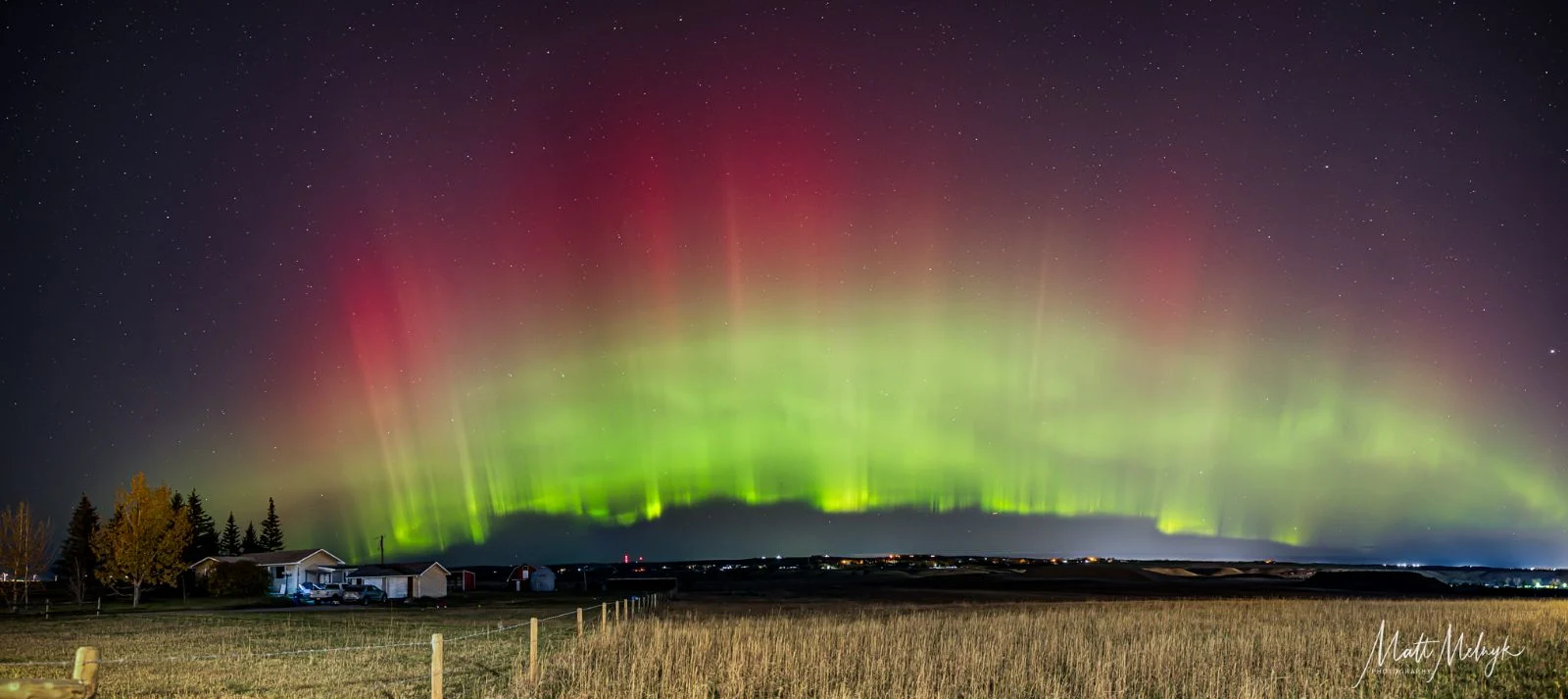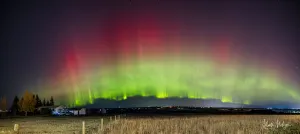
Bright Northern Lights possible tonight after arrival of speedy solar storm
Eyes to the sky! More aurora displays may be on the way following a powerful solar flare and the eruption of an exceptionally fast solar storm.
A massive cloud of high-energy particles exploded from the Sun overnight, and this fast-moving solar storm could spark bright auroras across Canada and the United States when it arrives on Thursday.
Late on Tuesday night, a powerful explosion went off on the surface of the Sun — an X1.8-class solar flare, originating from sunspot AR3848.

The X1.8-class solar flare is shown here, from around 10 p.m. to midnight EDT, on Tuesday, October 8, 2024. Initially, the flare lights up the surrounding solar matter in the shape of an immense fiery phoenix, and then changes appearance as multiple coronal loops stretch across to bridge the two sides of this immense sunspot. These views are filtered to only capture high energy ultraviolet radiation, at 171 Angstroms, which highlights coronal loops and solar flares. (NASA's Solar Dynamics Observatory)
While not as powerful as the flare we saw back on October 2, it has already had a two-fold effect on Earth.
First, it caused a strong radio blackout event on the day-side of the planet as x-rays and intense ultraviolet radiation bombarded Earth's ionosphere. Second, it unleashed a rare solar radiation storm, as a cloud of high-energy particles was accelerated to near the speed of light by the energy of the flare. Solar radiation storms are capable of causing problems with orbiting satellites, and they can even pose a risk to astronauts on board the International Space Station. Exceptionally strong solar radiation storms can even pose an elevated radiation exposure risk to high latitude flights, as those same solar protons stream into Earth's atmosphere near the poles.
A third impact from this solar flare is still on its way here: an immense coronal mass ejection, aimed directly at Earth.

The initial hour of expansion of the October 9 coronal mass ejection is shown along the top of this composite image, and the next two hours after are shown along the bottom. The bright white arch along the left side of each bottom frame is bright comet C/2023 A3 (Tsuchinshan-ATLAS) passing through the camera's field of view. (NASA-ESA Solar and Heliospheric Observatory)
This bright CME was spotted in the hours after the flare, as it expanded away from the Sun. According to NOAA's Space Weather Prediction Center, this solar storm is travelling exceptionally fast — at 1,200 to 1,300 kilometres per second. That is roughly two and a half times faster than the typical speed of a CME.
Thus, rather than taking the usual two to three days to arrive here, this solar storm is expected to reach Earth as early as Thursday morning.

The October 8-9 coronal mass ejection expands away from the Sun in this composite image from SDO and SOHO. While the left image is a combination of SDO's view of the Sun and both LASCO coronagraph views of the space around the Sun at the same time, the right image is the same but with labels for the CME, the planets Mercury and Venus, Comet Tsuchinshan-ATLAS, background stars, and the "snow" caused by the solar radiation storm's impact on the coronagraph camera. (NASA SDO/NASA-ESA SOHO/Scott Sutherland)
The impact of a coronal mass ejection, and its potential to spark auroras, mainly depends on four factors. The speed, energy, and density of the CME cloud account for three of these. Basically, the more solar matter that erupts, and the greater the energy absorbed by those particles, and the faster it sweeps past us, the higher the potential for bright, widespread aurora displays.
The fourth factor, which can be the most important, is the magnetic field carried by the CME cloud. Along with all of the other factors a CME takes with it from the Sun, the massive cloud of charged solar particles also has a magnetic field of its own.

This diagram shows Earth's geomagnetic field vs a CME magnetic field (represented by tiny bar magnets arrayed around both). In the top frame, the magnetic fields match direction, and thus repel each other. In the bottom frame, the magnetic fields match direction, and thus attract each other. The bottom scenario is more likely to cause bright aurora displays. Note: Earth's geomagnetic field is oriented with magnetic north in the Antarctic and magnetic south in the Arctic. This is why the north point of a magnetic compass always points towards the north pole, since it attracted to the south magnetic pole of Earth's magnetic field. (Scott Sutherland/Javalab)
When two bar magnets are brought together, their matching poles will produce a repulsive force, while heir opposite poles will attract. The same thing happens when a CME's magnetic field interacts with Earth's geomagnetic field. When the fields match direction, most of the CME particles flow around Earth with little effect. The more the fields are opposite to one another, though, the more magnetic connections the two will make, which will allow more solar particles to stream into the atmosphere to produce auroras.
DON'T MISS: Solar max is nearly here! Here's the science behind (and where to see) the Northern Lights
Geomagnetic storm warning and watch
These forecasts have been updated as of 3:50 p.m. EDT on Thursday, October 10.
According to NOAA's Space Weather Prediction Center, the arrival of this fast-moving CME has sparked a G4 geomagnetic storm, with potential for G5 (extreme) conditions at times throughout the rest of Thursday. They have issued a geomagnetic storm warning as a result.
"The anticipated coronal mass ejection (CME) arrived at Earth at 11:15 a.m. EDT at nearly 1.5 million miles per hour. The CME strength and structure are being closely scrutinized for potential geomagnetic storm intensity, but, G3 levels are now expected due to the magnitude and potential of the CME, therefore G3 or greater warning has been issued. G4 (Severe) levels remain likely with the watch still in effect and even a slight chance of G5 (Extreme) levels due to initial observations of the CME strength," SWPC said in their latest update.

The Planetary K-Index forecast (a measure of geomagnetic and aurora activity) is shown here for the nights of Oct 9-10 through Oct 11-12 (EDT). The white times on the left are in Universal Coordinated Time (UTC), the yellow times are EDT. Under each date, the forecast Kp and Geomagnetic Storm strength are shown in 3-hour blocks of time. (NOAA SWPC)
With that timing, the G3 (strong) to G4 (severe) geomagnetic storm conditions are starting during daylight hours for North America. Thus, no auroras will be seen over Canada or the United States from the start of this event. However, there is strong potential for these geomagnetic storm levels to persist, and even reach G5 (extreme) in the hours ahead.
As of 5 p.m. EDT, NRCan's Canadian Space Weather Forecast Centre had observed major geomagnetic storm conditions in the polar and auroral regions of northern Canada, with stormy conditions in the sub-auroral region of southern Canada and the northern United States. As of now, conditions have diminished to 'stormy' in the polar and auroral regions, but they have increased to major storm levels in the sub-auroral region! The forecast looks as though these conditions will persist for some time, as well.

The 6 hour (left) and 24 hour (right) forecasts for geomagnetic activity in the polar, auroral, and sub-auroral regions over Canada and the northern United States, for October 10-11, 2024. (Space Weather Canada/Natural Resources Canada)
As shown above, they are expecting stormy geomagnetic activity in all regions (polar, auroral, and sub-auroral) for the next six hours. A major geomagnetic storm watch in effect from 11 a.m. EDT on Thursday through 12 p.m. EDT on Friday for the auroral region as well. The major storm conditions are expected to persist for polar and auroral regions for the next 24 hours, with active to stormy conditions in the sub-auroral region.
A solar storm sweeps past
As of about 10:40 a.m. EDT, the Advanced Composition Explorer (ACE) & Deep Space Climate Observatory (DSCOVR) satellites, located at Lagrange Point 1, a million and a half kilometres closer to the Sun than us, recorded the arrival of this CME.

Space weather conditions at Lagrange Point 1, recorded by ACE and DSCOVR. (NOAA SWPC)
The above graph shows the increase in the magnetic field strength, density, speed, and temperature (energy) of the particles flowing past these spacecraft (red box). With the magnetic field direction of the particles in the cloud being mostly negative (black box), the CME's magnetic field will be connecting with Earth's geomagnetic field rather than pushing against it. That indicates favourable conditions for auroras.
Given that it's daytime now on this side of the planet, auroras will not be visible in the sky to start. However, depending on how long these geomagnetic conditions last, there could still be aurora displays visible tonight.
Stay tuned for more updates!
Thumbnail image courtesy Matt Melnyk, who captured this view of the Aurora Borealis north of Calgary on Oct 6, 2024.










